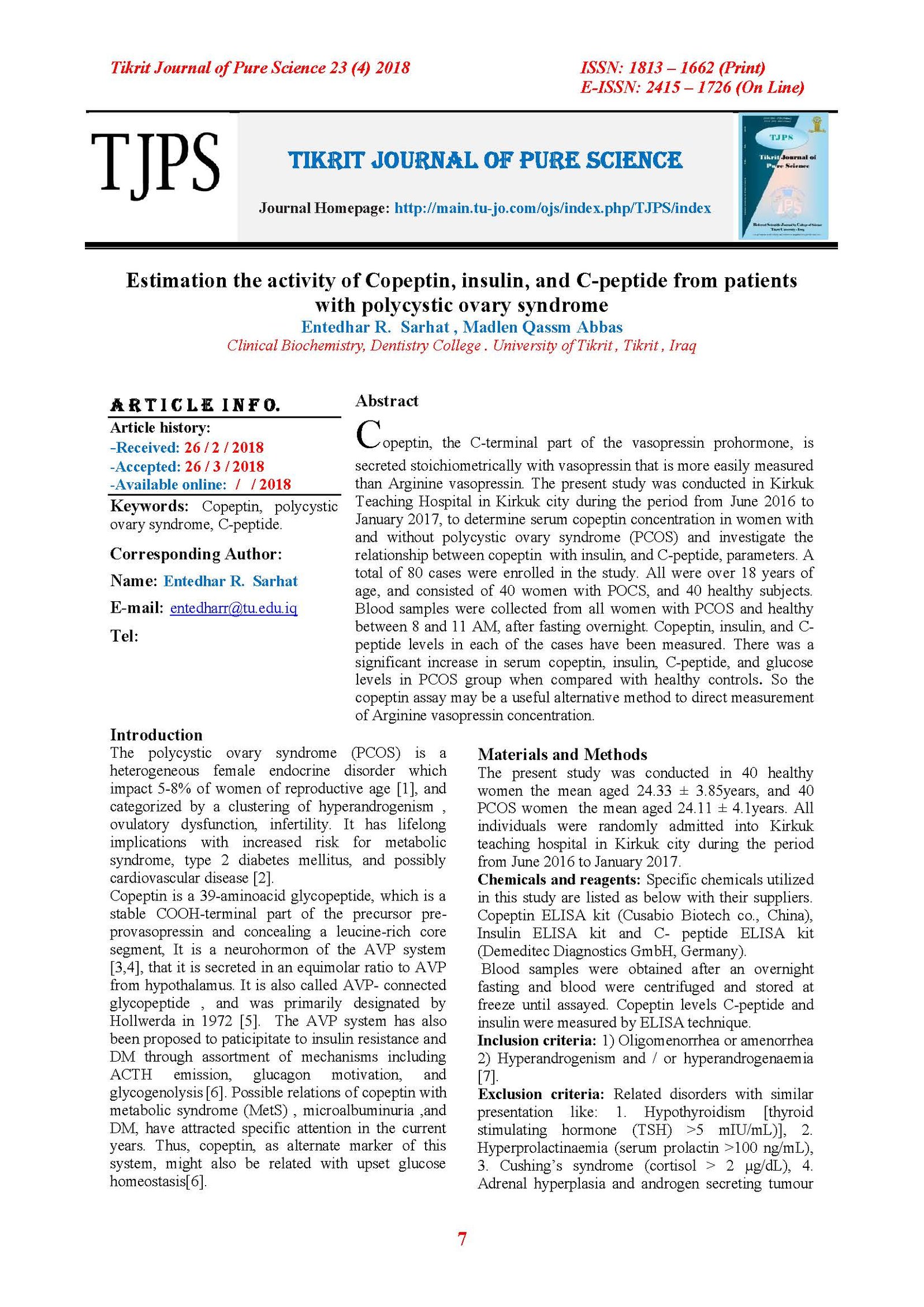Estimation the activity of Copeptin, insulin, and C-peptide from patients with polycystic ovary syndrome
Main Article Content
Abstract
Copeptin, the C-terminal part of the vasopressin prohormone, is secreted stoichiometrically with vasopressin that is more easily measured than Arginine vasopressin. The present study was conducted in Kirkuk Teaching Hospital in Kirkuk city during the period from June 2016 to January 2017, to determine serum copeptin concentration in women with and without polycystic ovary syndrome (PCOS) and investigate the relationship between copeptin with insulin, and C-peptide, parameters. A total of 80 cases were enrolled in the study. All were over 18 years of age, and consisted of 40 women with POCS, and 40 healthy subjects. Blood samples were collected from all women with PCOS and healthy between 8 and 11 AM, after fasting overnight. Copeptin, insulin, and C-peptide levels in each of the cases have been measured. There was a significant increase in serum copeptin, insulin, C-peptide, and glucose levels in PCOS group when compared with healthy controls. So the copeptin assay may be a useful alternative method to direct measurement of Arginine vasopressin concentration.
Article Details

This work is licensed under a Creative Commons Attribution 4.0 International License.
Tikrit Journal of Pure Science is licensed under the Creative Commons Attribution 4.0 International License, which allows users to copy, create extracts, abstracts, and new works from the article, alter and revise the article, and make commercial use of the article (including reuse and/or resale of the article by commercial entities), provided the user gives appropriate credit (with a link to the formal publication through the relevant DOI), provides a link to the license, indicates if changes were made, and the licensor is not represented as endorsing the use made of the work. The authors hold the copyright for their published work on the Tikrit J. Pure Sci. website, while Tikrit J. Pure Sci. is responsible for appreciate citation of their work, which is released under CC-BY-4.0, enabling the unrestricted use, distribution, and reproduction of an article in any medium, provided that the original work is properly cited.
References
1. Azziz R, Woods KS, Reyna R, Key TJ, Knochenhauer ES, Yildiz BO.(2004). The prevalence and features of the polycystic ovary syndrome in an unselected population. J Clin Endocrinol Metab. 89 (6):2745-2749.
2. Entedhar R. Sarhat , Thuraia R. Sarhat. (2016).Study of Paraoxonase and Adiponectin in Polycystic Ovarian Syndrome. Third Women Scientific Conferences, University of Baghdad,162-168.
3. Voors AA, von Haehling S, Anker SD, Hillege HL, Struck J, Hartmann O, Bergmann A, Squire I, van Veldhuisen DJ, Dickstein K.(2009). Optimal Investigators: C-terminal provasopressin (copeptin) is a strong prognostic marker in patients with heart failure after an acute myocardial infarction: results from the OPTIMAAL study. Eur Heart J,30:1187–1194. 4. Morgenthaler NG, Struck J, Jochberger S, Dünser MW. (2008). Copeptin: clinical use of a new biomarker. Trends Endocrinol Metab,19: 43–49. 5. Holwerda DA: (1972).A glycopeptide from the posterior lobe of pig pituitaries. I .Isolation and characterization. Eur J Biochem, 28: 334–339.
6. Enhörning S, Wang TJ, Nilsson PM, Almgren P, Hedblad B, Berglund G, Struck J, Morgenthaler NG, Bergmann A, Lindholm E, Groop L, Lyssenko V, Orho - Melander M, Newton-Cheh C, Melander O: (2010).Plasma copeptin and the risk of diabetes mellitus. Circulation.121:2012–2108.
7. Karbek B, Ozbek M, Karakose M, Topaloglu O, Bozkurt NC, Cakır E, Aslan MS, and Delibasi T (2014). Copeptin, a surrogate marker for argininevasopressin, is associated with cardiovascular risk in patients with polycystic ovary syndrome. J Ovarian Res; 7:31.
8. Taskin MI, Bulbul E, Adali E, Hismiogullari AA and Inceboz U (2015). Circulating levels of obestatin and copeptin in obese and non-obese women with polycystic ovary syndrome. European J. Obstetrics and Gynecol. Reprod. Biol. 8938 ;1–5 9. Saleem U, Khaleghi M, Morgenthaler NG, Bergmann A, Struck J, Mosley THJ, Kullo IJ.(2009). Plasma carboxy-terminal provasopressin (copeptin): A novel marker of insulin resistance and metabolic syndrome. J Clin Endocrinol Metab.94:2558–64.
10. Entedhar R. (2014). Relationship between Leptin, Adiponectin and C-peptide with Paraoxonase in obese individuals. Ph.D. thesis, University of Tikrit. Iraq.
11. Dunaif A. (1997). Insulin resistance and the polycystic ovary syndrome: mechanism and implications for pathogenesis. Endocr Rev. 18(6): 774 –800.
12. Burghen GA, Givens JR, Kitabchi AE. (1980). Correlation of hyerandrogenism with hyerinsulinism in polycystic ovarian disease. J clin Endocrinol Metab.50:113- 117.
